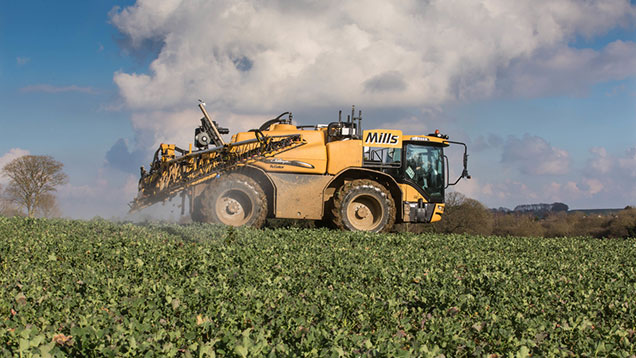PGR product launched to help raise oilseed rape yield
 © Tim Scrivener
© Tim Scrivener A plant growth regulator product has been approved for use in oilseed rape and will help growers manage crop canopy structure to maximise yield, its manufacturer says.
Toprex contains specific PGR active ingredient paclobutrazol – used widely in horticulture and ornamental-plant production – alongside azole fungicide difenoconazole.
In addition to growth regulation, the product also has activity on yield-robbing oilseed rape diseases phoma and light leaf spot.
It will be a useful addition to the toolbox for growers this spring as many crops established well and have come through the mild winter with overdense canopies.
See also: Double up on lush oilseed rape canopies to hit high yields
James Evans, manufacturer Syngenta’s oilseed rape technical manager, says it will enable growers to develop the right plant architecture, helping to increase yield and make crops easier to manage through until harvest.
“It is effective at reducing overall height of the plant, increasing rooting and producing a more compact structure that enhances green leaf and photosynthetic area,” he adds.
Toprex has also been shown to create more uniform crops with a shorter flowering period, resulting even crop maturity, less pod shatter and a more consistent seed sample.
Testing season
Independent agronomist Sean Sparling will be testing some Toprex out this spring and welcomes the addition of another specific PGR to use in oilseed rape.
Many growers rely on fungicides with PGR effects, such as tebuconazole or metconazole, to control disease and reduce lodging risk by shortening the crop, strengthen stems and increase rooting.
Mr Sparling believes Toprex will come into its own where growers haven’t yet started their PGR programme and large canopies are a concern.
“Where disease control – and particularly light leaf spot – is a priority, there are stronger products on the market. It’s about identifying whether lodging risk or disease control is your biggest concern.”
Sean Sparling, independent agronomist
“Leggy crops in autumn have already received some growth regulation across my area, but where that’s not the case a specific PGR such as Toprex could be a good option.
“Where disease control – and particularly light leaf spot – is a priority, there are stronger products on the market. It’s about identifying whether lodging risk or disease control is your biggest concern,” he says.
The product will be best applied at the onset of stem extension this spring, although it is approved up to the green/yellow bud stage (GS55) and joins BASF’s Caryx (mepiquat + metconazole) as the only specific PGRs for oilseed rape growers.
Following crop
One of Toprex’s active ingredients, paclobutrazol, has significant following crop restrictions and Mr Sparling urges growers considering using the product to check the label to ensure it won’t effect on their planned rotation.
“The other fungicides we use are fairly benign in terms of their effect on the following crop, so it may influence you decision,” he adds.
Only cereals can be grown after using Toprex and in the case of OSR crop failure in the autumn, one month must have passed before a cereal crop can replace it.
Broad-leaved crops such as oilseed rape cannot be grown until 16 months have elapsed after treatment and potatoes cannot be established within three years.

